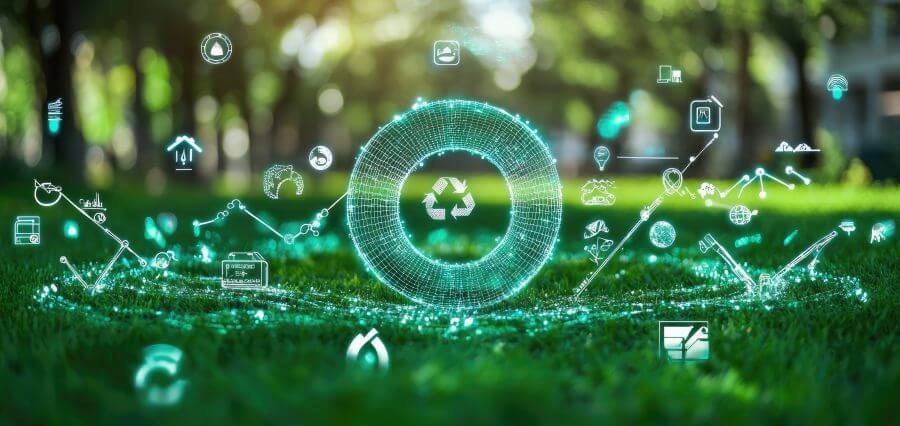E-waste Recycling and Sustainable Electronics
Technology has now become an integral part of life today. From laptops to cell phones, products change hands every two or three years on average, encouraging rapid growth but an expanding environmental concern—e-waste. By 2022, the world produced more than 62 million metric tons of e-waste, less than 25% of which was found to be officially recycled by the Global E-waste Monitor. Against this backdrop, the circular economy principle—that is, product and system design to limit waste and promote reuse—is finding increasing favour within the technology sector.
This case study outlines how companies are adopting circular methods, rooted in e-waste recycling, sustainable product design, and new models of business that extend the lives of electronics.
Why Circular Economy Matters in Technology
The traditional “take-make-dispose” approach has yielded massive quantities of toxic waste, natural resource destruction, and environmental danger. Electronics are made of valuable resources like gold, copper, lithium, and rare earths. They cannot be recycled, so they’re gone for good, and poisonous dumping pollutes land and water.
The circular economy in tech fixes these issues with:
- Product longevity: Creating goods to last, be repaired, and be upgradable.
- Recovery and recycling: Recycling of useful materials from obsolete products.
- Closed-loop systems: Recycling as new products.
- New business models: Leasing, refurbishment, and resale to reduce consumption.
Case Study 1: Dell’s Closed-Loop Recycling Program
Dell pioneered circular electronics with its closed-loop recycling program. Dell recycles old computers, recycles plastic, and they’re used in new products. Dell also employs recycled gold extracted from waste electronics in motherboards and jewelry.
Dell also aims to, by 2030, make the equivalent value product recycled or reused for each product sold. Already, more than 125 million pounds of sustainable material have been used within its products.
Key Takeaway: Mass producers can contribute quantifiably by incorporating recycling systems within supply chains.
Case Study 2: Fairphone – Designing for Repairability
The company Fairphone from the Netherlands revolutionized the production of phones by focusing on ethical production and modularity. Unlike mass-market phones, which are glued together and supported by special screws, Fairphones are constructed with removable parts such as cameras, batteries, and screens.
This design product stretches product lifecycles and allows people to repair, not dispose. Fair working conditions and conflict mineral ethical sourcing are promoted by the company as well. Small as it is in market share, Fairphone makes a huge impact by shaping industry debate over Right to Repair and green design.
Key Takeaway: Circular economy’s core is product design innovation, which upsets disposability culture.
Case Study 3: Apple’s Daisy Robot and Material Recovery
Apple, the world leader in electronics manufacturing, has incorporated circular business models in its Daisy robot to bulk disassemble iPhones to recover cobalt, tungsten, and rare earth. Apple also uses recycled aluminum in almost all its products and wishes that all of its products would be made from 100% recycled or renewable sources in the future.
Through proprietary recycling technology investment, Apple demonstrates how big businesses can make efficiency and material recovery in bulk.
Key Takeaway: Automation and robotics have the potential to accelerate e-waste recycling, reducing the need for virgin mining.
Case Study 4: Closing the Loop – Circular Supply Chains in Africa
Netherland social business Closing the Loop collects discarded phones in Africa on behalf of telcos and NGOs, and sends them on to regulated recyclers in Europe. The telcos receive “waste compensation” credits against their sales in exchange.
In addition to reducing global e-waste, it creates employment locally and prevents developing countries from embracing hazardous waste management, since informal recycling in these nations is associated with toxic exposure.
Key Takeaway: Circular economy projects have the possibility of integrating environmental objectives and social impact, particularly in developing economies.
Challenges to Circular Tech
Although circular economy technology has potential, there are a few hurdles to overcome:
- Economic Viability: Recycling scarce materials tends to be more expensive than extracting new ones.
- Consumer Behavior: Consumers continue to be steadfast on having newer models at the cost of longevity of products.
- Regulatory Gaps: Inadequate enforcement of e-waste policies in the developing world enables informal, hazardous recycling.
- Design Trade-offs: Aesthetic or performance goals may be in conflict with repairability design.
These problems need to be solved through collaboration between governments, industry, and consumers.
Future Outlook: Toward Circular Electronics
Technology is moving more rapidly towards circular economies, led by regulation and demand from customers. The Right to Repair directive has also been initiated by the European Union, which forces manufacturers to release spare parts and repair manuals. Startups are also leading device-as-a-service models, whereby firms are leasing equipment instead of selling them, enabling enhanced management of the lifecycle.
New technologies like AI-driven recycling machines, blockchain-based material, and biodegradable electronics will revolutionize the business. Circular economies by 2030 will conserve the world 30–40% of e-waste, conserving resources and preventing climate destruction.
Conclusion
The circular economy is a paradigm change for the tech industry. From robot disassembly by Apple to modularity by Fairphone and closed-loop recycling by Dell, real-world results prove that green electronics are not only wanted—possible. The economics, the policies, and the attitudes are still an issue, but the stampede toward circularity cannot be denied.
In an age where innovation is more often sought after by sacrificing sustainability, the circular economy offers a blue print on achieving tech progress and earthliness. As new-age startups or as multinational giants, embracing circularity is no longer optional—it is the way to resiliency and sustainability in the digital world age.




